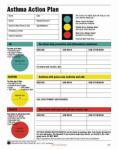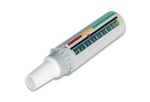I’ve moved!
Please stop by, heck, bring a friend, and welcome the Asthma Advocate at my new home: http://www.theasthmaadvocate.com
I look forward to your visit, and welcome housewarming presents in the form of post comments. I hope to see you there!
Five lessons from our battle with the swine flu
Despite my hyper-vigilance to protect my family from the swine flu, the virus invaded our house last week. It all started with a throat-clearing cough last Thursday. My husband, a day after visiting the Children’s Hospital of Philadelphia with our daughter, declared he must have picked up a cold. Friday morning, he woke up feeling terrible. Saturday night he was in the ER, dehydrated, while the nurses fought to control his nausea, bring his fever down, and replenish his system with fluids. While we were there, the doctor swabbed him for the flu; the results came back that he was Type A positive, which the doctor explained essentially meant that he had swine flu. “You know, this is really going to affect our sex life,” I told him.
Monday morning the swine flu launched its attack on two more victims – Ava and Andrew both woke up with fevers. While their symptoms were mild, I knew their asthma put them at risk for complications. Both of their doctors recommended they follow their red zone treatments plans which meant around-the-clock nebulizer treatments, prednisone, and chest pt.
Ten days out from the initial attack, the house is finally calm. Jason is re-bounding from the pneumonia that developed from the virus and Ava still has mild wheezing, but overall things are much better.
It’s strange to write, but with everyone catching the swine flu I feel like a weight has been lifted from my shoulders. I have been so cautious of the kids catching the virus and now that they have survived it, I feel like I can loosen up a bit. The next time I go to the supermarket, maybe I won’t even disinfect the shopping cart handle. Hell, maybe I’ll even let the kids lick the handle. They’ve survived swine flu, they’re invincible!
A few lessons I’m compelled to share from our experience:
- The health care system is woefully underprepared for this virus, so prepare yourself, and your family, the best you can.
- Tamiflu helps. Whether it’s a prophylactic treatment or used once symptoms begin, the tamiflu eased symptoms for the kids and, in my case, prevented me from catching the virus. My husband, the only one not to take the tamiflu, was the sickest he has ever been.
- If you have been exposed to the virus, tell your health care provider that you, or your child, has asthma. Your treatment plan may vary.
- Communicate regularly with your child’s doctor. The swine flu can cause serious health issues in a very short time frame. If your child’s symptoms change it’s important to alert your doctor ASAP.
- The swine flu spreads faster than internet gossip. Act quickly to protect yourself, or your children, once you have been exposed.
When asthma and the swine flu collide
 We have been watching a lot of Incredible Hulk re-runs in our house lately. In one episode, a rogue scientist mixes the Hulk’s blood with the blood from an evil superhuman monster. When the combination is injected into the veins of a human seeking super powers, the result is cataclysmic. This is how I imagine the swine flu will look when it hits a child with asthma.
We have been watching a lot of Incredible Hulk re-runs in our house lately. In one episode, a rogue scientist mixes the Hulk’s blood with the blood from an evil superhuman monster. When the combination is injected into the veins of a human seeking super powers, the result is cataclysmic. This is how I imagine the swine flu will look when it hits a child with asthma.
Like myself, I suspect many parents of asthmatic children are concerned about the H1N1 virus and how it will affect our kids. Some of us may overreact (like me), while others aren’t concerned at all. What’s important, is that we gather all of the information we can to make an educated health care decision for our children.
Many talking heads are saying the swine flu is no different from the regular flu. Is that also true for children with asthma? What about the vaccine – is it safe?
Before talking with your doctor about your child and the swine flu, it’s important to gather the facts so that your conversation is an informed one. Because the swine flu doesn’t have to be a calamitous green, bug-eyed beast.
To find asthma resources near you
Last night I attended the American Lung Association’s Asthma Walk committee meeting. It was inspiring to meet committee members, most of them health care professionals, and learn about their commitment to raising asthma awareness in the community.
If you aren’t familiar with the ALA, I encourage you to visit their website, type in your zip code, and learn more about chapter activities near you. Through my work with the ALA I have learned about asthma camps, health care events in our area and how I can support legislation to improve the quality of the air we breathe. I also got this cool chair for our team’s stellar fundraising efforts!

!
Creating an asthma toolbox
With access to your own asthma toolbox, you can help your child’s doctor tailor a treatment plan that gets your child better, quicker. Sometimes children aren’t able to find the words to describe their asthma symptoms. If you have ever asked your child how her day at school went only to be answered with a blank stare and shoulder shrug, then you know what the doctor is up against. With just a few simple tools, you can become an asthma detective and improve the way you advocate for your child’s health.
Standard Toolbox: stethoscope, action plan, updated prescriptions (including spacers & nebulizers), journal.
Deluxe Toolbox: stethoscope, action plan, updated prescriptions (including spacers & nebulizers), peak flow meter, journal, pulse oximeter.
Stethoscope: In my opinion, this is the most valuable tool in an asthma toolbox. Learning how to use a stethoscope has helped me immensely in detecting my children’s flares before they hit the red zone.
Distinguishing between lung sounds has also made me a stronger communicator with Ava and Andrews’ doctors. During your child’s next appointment, and during all future appointments, ask your doctor if you can listen to your child’s lungs through his/her stethoscope. If your child isn’t flaring, you will have an opportunity to hear how your child’s lungs sound when air moves through them easily. If your child is flaring, the doctor will give you an audible demonstration of the sounds your child’s lungs make when they are compromised. For additional background information on lung sounds, visit here.
 Action Plan: Do not leave your child’s asthma appointment without an action plan! If a plan is not offered during the appointment, ask for it. It’s also important for parents and doctors to collaborate while developing the plan. Asthma looks very different from child to child – so it’s important for you to speak up if the standard action plan is not tailored to your child. Click here for additional information on action plans.
Action Plan: Do not leave your child’s asthma appointment without an action plan! If a plan is not offered during the appointment, ask for it. It’s also important for parents and doctors to collaborate while developing the plan. Asthma looks very different from child to child – so it’s important for you to speak up if the standard action plan is not tailored to your child. Click here for additional information on action plans.
Updated Prescriptions: As your child’s medications change, so should the contents of your toolbox. Instead of tossing old medications in the trash, talk with your pharmacist about the best way to discard unused or old inhalers and other medications. Keep asthma-related prescriptions in your toolbox to help you remember when medications need to be refilled.
 Peak Flow Meter: It’s been my experience that doctors have varying opinions regarding peak flow meters. Generally, asthma patients aren’t able to accurately give a readable peak flow reading until they are five years old and have mastered the technique of forcefully blowing air into the meter in the defined period of time. Since every asthmatic is different, talk with you doctor about whether or not a peak flow meter is appropriate for your asthma toolbox.
Peak Flow Meter: It’s been my experience that doctors have varying opinions regarding peak flow meters. Generally, asthma patients aren’t able to accurately give a readable peak flow reading until they are five years old and have mastered the technique of forcefully blowing air into the meter in the defined period of time. Since every asthmatic is different, talk with you doctor about whether or not a peak flow meter is appropriate for your asthma toolbox.
Journal: During a doctor’s appointment, it can be difficult to recall all of your child’s flares and the events leading up to the asthmatic response. By keeping track of flares in a journal, or on a calendar, you can help your child’s doctor figure out what triggers your child’s asthma (whether it’s seasonal, environmental, allergic, or triggered by viruses).
 Pulse Oximeter: This device measures oxygen saturation in the blood. A pulse oximeter (pulse ox) reading of 100 percent is great, whereas a pulse ox level around 90 percent is generally a cause of concern. For children with a history of low pulse ox readings, you should talk with your doctor about the value of purchasing a pulse ox to keep at home. Your child’s pulse ox reading is valuable information to share with your doctor when your concerned about their health
Pulse Oximeter: This device measures oxygen saturation in the blood. A pulse oximeter (pulse ox) reading of 100 percent is great, whereas a pulse ox level around 90 percent is generally a cause of concern. For children with a history of low pulse ox readings, you should talk with your doctor about the value of purchasing a pulse ox to keep at home. Your child’s pulse ox reading is valuable information to share with your doctor when your concerned about their health
Are there other tools that have been helpful to you?
Really CDC?
News arrived today that the first swine flu vaccines will be available the first week of October. Good news, right? This is the news I’ve been waiting for. Where do I sign my kids up? Get me on the waiting list!
But wait. This news was shortly followed by the news that the first swine flu vaccines will be of no use to asthmatic kids. Why? Because the first vaccines are only available in a nasal spray, which is not recommended for asthmatics and pregnant women – the population at highest risk for severe complications from the H1N1 virus.
Thanks CDC!
And so it begins

Puddles of mucus are collecting under their noses. Out of the inner corner of their eyes protrude tiny green balls of grossness, the size of butterfly eggs. The cough is mild and intermittent, but you fear you it may get worse. Is an asthma flare around the corner?
I’ve always been a fan of summer, preferring it to crisp football weather in the fall and even the burgeoning warm weather of spring. But having two children with asthma has given me even more reason to loathe these seasons. The change of weather consistently unearths unfavorable changes in my children’s health. Even though your child, like my Ava and Andrew, may have tested negative for common fall allergens such as ragweed and mold, that doesn’t necessarily mean the change in environs won’t irritate their immune system.
I realize we’re not officially into fall just yet, but it has been my experience that colds and viruses proceed the scheduled elliptical orbit of Earth. I’m curious to know if your household been hit yet?
Time to blow off the dust and prime the inhaler
Your child has been doing great all summer. His asthma episodes have been few and far between and you haven’t used his quick relief inhaler in so long that it’s collecting more dust than last year’s book bag.
Unfortunately, the end of August and early September is a period when asthma patients begin to flare again. This is the time of year when pediatric pulmonary and allergy/asthma offices are flooded with patients. Some of the reasons your child’s asthma may act up include the seasonal change from summer to fall, the indoor air quality of their school, the close proximity to other children who may be carrying viruses, and of course allergies (ragweed and molds are especially bad in the fall).
If your child’s asthma has a tendency to flare during this time, talk with your doctor now about adjusting his medication. If you weren’t fortunate enough to grab a coveted August or September appointment, call or e-mail your doctor for advice on how to prevent flares until you’re able to schedule an appointment.
If you do nothing, managing your child’s asthma this fall will be more challenging than getting him to do homework while it’s still light out after dinner. Prevention is key!
Karen manages asthma and the unexpected
In 2008, when heavy rains flooded the town of Waterloo, Iowa, many residents were left homeless. Karen and her three children were out of their house for nine months, living in a small rental property. “It was a big change for the kids,” says Karen, a single parent to three children with health issues, including two with asthma and allergies. But Karen has kept her children thriving with her advocacy efforts and asthma management. Karen talks “asthma” with us here:
When were your children diagnosed with asthma?
Joshua was diagnosed with asthma at four weeks old. His triggers have increased over the years, and they are: cigarette smoke, viruses, exercise, and humidity.
Rose was officially diagnosed with August of 2008. Her triggers are EVERYTHING. She has hay fever,which exacerbates her asthma, so being outside is a challenge. Rose’s asthma is also triggered by cigarette smoke, viruses, exercise, hot weather, cold weather, and peanut products, which she is allergic to.
As the mom of two asthmatic children, what recommendations do you have for other parents?
My advice for moms is to follow your motherly instincts when it comes to getting answers for your kids. Also, teach your kids about their triggers and practicing avoidance. For example, both Joshua and Rose have food allergies, that also cause their asthma to flare. If there is a question, the kids know to ask if something is “safe” to eat.
Asthma sucks, but my kids make the best out of it, and live their lives to the fullest even at young ages. They amaze me.
What is the status of your house?
We’re back at the house but I still have concerns about the water damage. Good news, however, arrived this week. I was reading the local paper and came across an article about a grant given to a doctor that is head of the local asthma association. The grant is going to be used for households of kids with asthma who were affected by the floods last year. As part of the grant, an air quality control expert, along with a respiratory therapist will come to your house free of charge. I believe we qualify, so I’m excited about the opportunity.

Rose, 3, was diagnosed with asthma last year.

Joshua, 5, was diagnosed with asthma at four weeks.

Siblings Joshua and Rose deal with their asthma by taking their medications and staying as active as possible.
Introducing Ashleigh and Jackson










